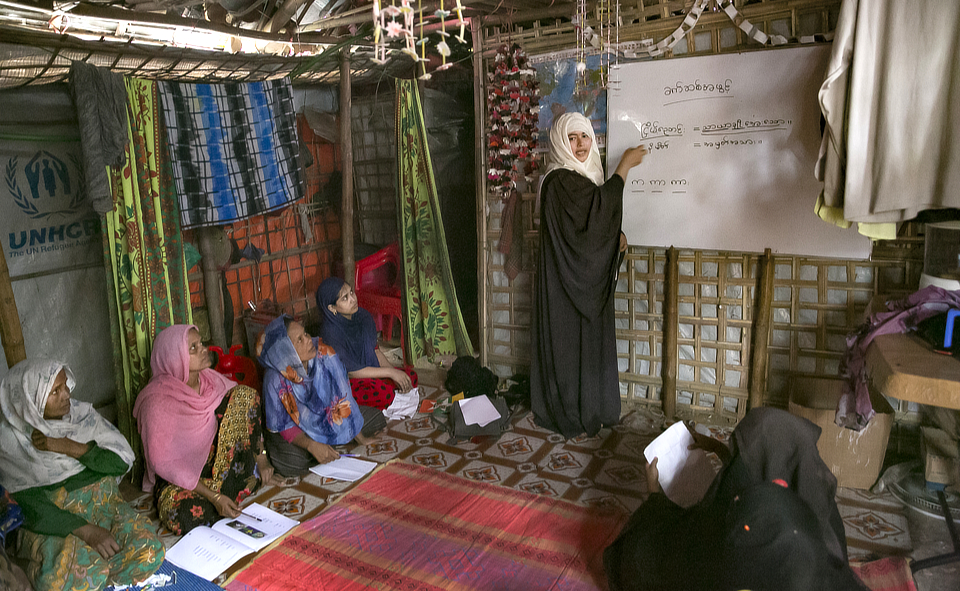Education programming for refugee women & girls: Findings from a needs assessment study
Date:
Author: Sunee Singh

With 1 billion students and youth across the globe affected by school and university closures, there is increasing debate around ongoing disruption in education. Many perceive this as a wake-up call to develop and adopt alternative education modalities such as interactive audio instruction through television, radio, and mobile phones.
These discussions and possible shifts, to a certain extent, can illuminate new paths forward for improved educational programming, but it can also exacerbate existing inequalities, particularly for women and girls.
In the Rohingya refugee camps in Cox's Bazar, where women and girls comprise 52% of the population, access to education has not been easy, given the conservative gender norms restricting their movement and access to information. For many, education remains a distant dream and an aspiration that might not happen, even if we are to provide access to devices and digital platforms.
Access to education is hindered further by the fact that humanitarian response in Cox's Bazar mainly prioritizes education for children and youth up to the age of 24. For organizations like UN Women, who are trying to develop women's leadership, achieve gender equality, reduce gender-based violence, and foster women's empowerment, educational programming for women and girls has become indispensable.
In trying to understand the most appropriate way to meet Rohingya women and girls' educational needs and develop ways forward, UN Women and Dan Church Aid (DCA) undertook a Needs Assessment study recently.
The study consulted women and girls in five different camps in Cox's Bazar. The study affirmed that most women and girls aspire to further their education, be it formal or non-formal, and are also keen to learn vocational skills. Women and girls are fully aware that education and skills will enhance their ability to adjust to and navigate their daily lives in refugee camps and help in their empowerment.
Considering the challenges, women and girls who participated in the study had several needs and recommendations, with important ones listed below. These recommendations are for Rohingya camps but can also apply in other contexts.
- Despite the overwhelming interest of women and girls in accessing education, it is not the availability and access to learning opportunities that necessarily pose the main problems. A common barrier was permission from the family members and community leaders. To overcome this, women and girls themselves recommend having a two-tiered sensitization approach – first to advocate with community leaders, religious and other respected authorities. Through these community stakeholders they will assist to sensitize and get 'buy-in' from family members.
- Foundational preparatory activities for women and girls are critical. These activities help them slowly adapt to learning new skills and not get overwhelmed, particularly if they have never had any exposure to formal or non-formal education opportunities. Developing a base level of literacy and numeracy is also essential for women in their daily lives.
- Life skills to help women and girls gain confidence and understand subject matters that affect their lives is essential. For instance, UN Women and DCA have included topics like nutrition, hygiene, conflict resolution, critical thinking, and discovering the strengths of peers, to complement the non-formal education for Rohingya women and girls.
- Particularly in refugee response, it is best to integrate educational programming into existing protection and GBV programs. UN Women is integrating educational activities into its Multi-purpose women's centers (MPWCs), which are female-only spaces. These activities will fully utilize the limited spaces in the camps while also providing services that enhance the well-being of women and girls, such as livelihood opportunities, counseling, case management, and paramedic services.
- A blended approach of center-based and home-based learning is most suited not only to build trust with key decision-makers at the community and household level, but also to cater to various other challenges of mobility of women and girls, constraints of physical spaces, and ensuring access for learners with disabilities, etc.
In addition to the above specific issues, other prerequisites like ensuring necessary gender-segregated facilities, female toilets, quality female teachers, provision of educational materials, and other incentives are fundamental. A recent UN Women and IOM study on gender norms that consulted the Rohingya communities highlighted the importance of engaging women and girls in education initiatives in female-only spaces by female teachers.
Further, "For education interventions to be successful for women and girls, we also have to consider all the intersected vulnerabilities to which women and girls are exposed. For women and girls residing in the Rohingya refugee camps, those vulnerabilities are myriad. However, so is the desire for education", says Margaret Goll, Education Program Manager from DCA.
Flora Macula, Head of Cox's Bazar Sub-office, concludes, "We need to incorporate education for women and girls within humanitarian response with the purview that education is a universal human right. And as humanitarian actors, we cannot deviate from the SDGs, especially with regards to 'SDG 4 on quality education for all 'and 'SDG 5 for Gender Equality".
Note: UN Women's education/learning activities are implemented in partnership with Dan Church Aid and is supported by the Government of Sweden.